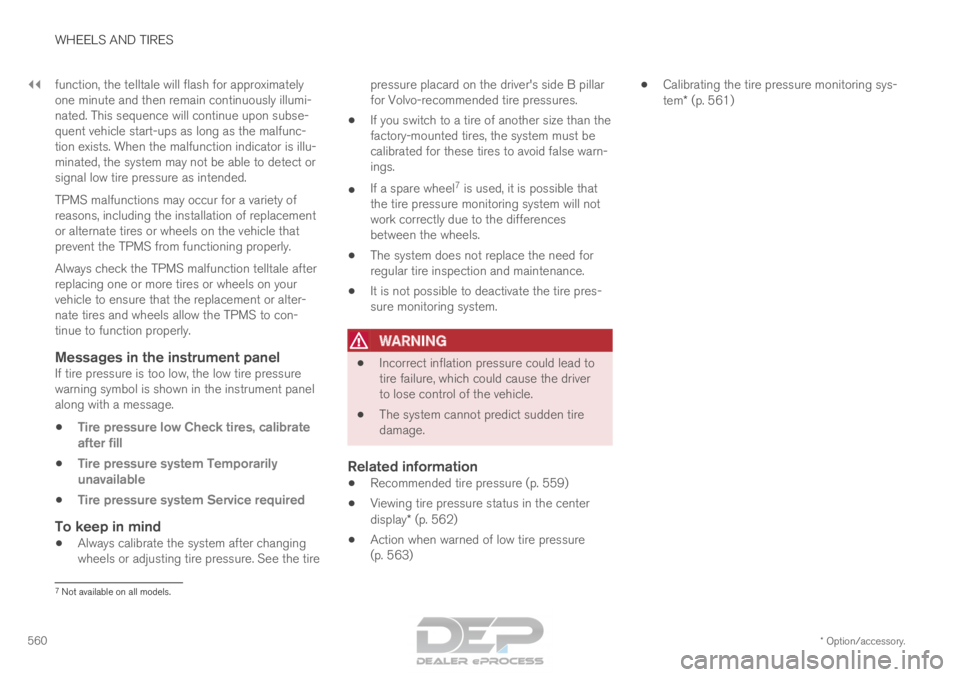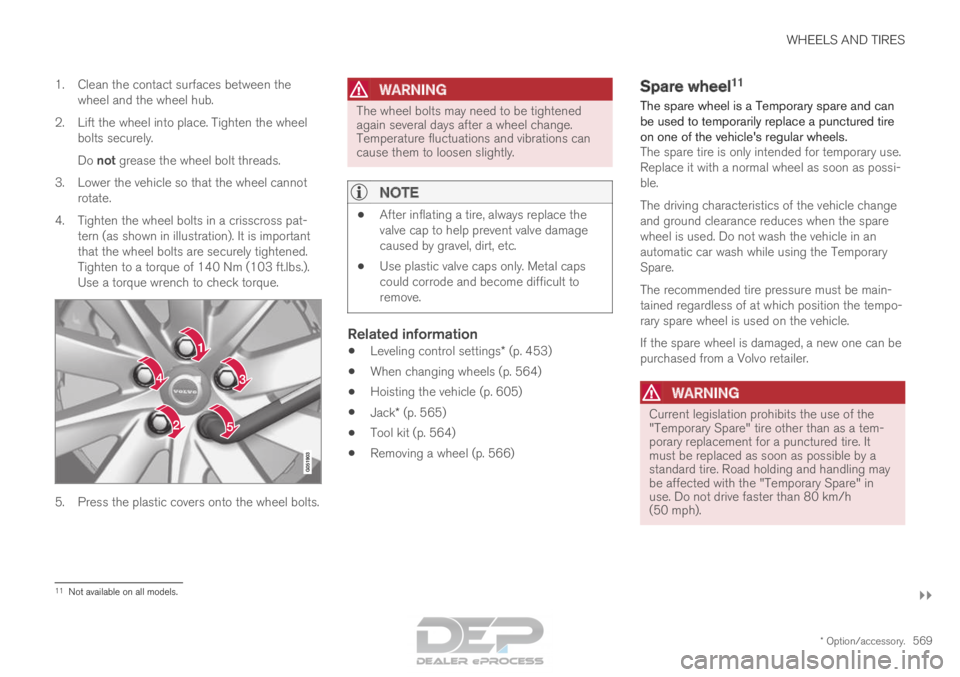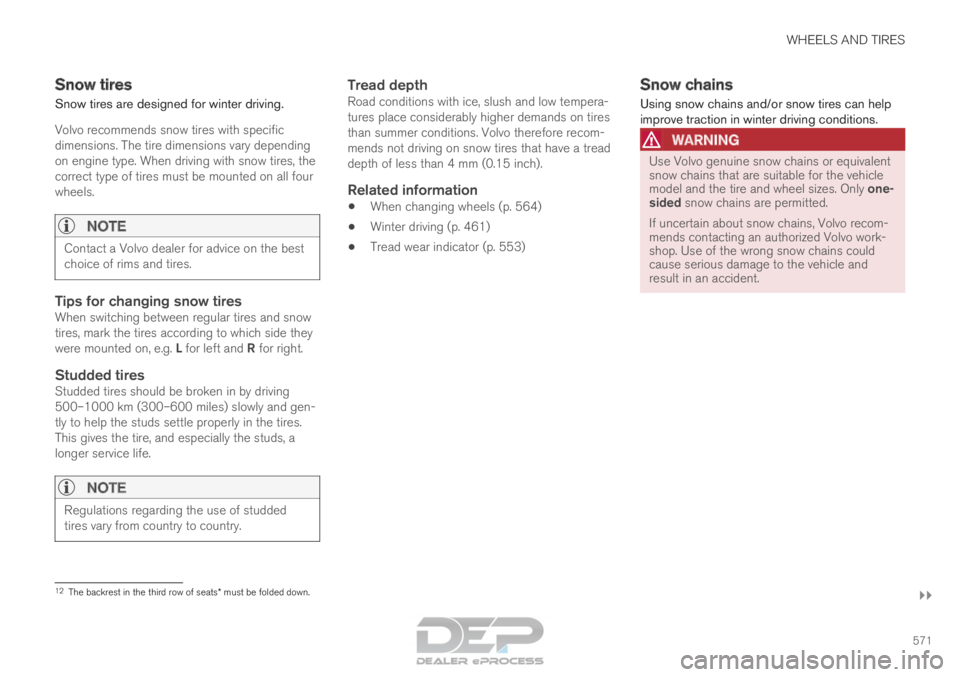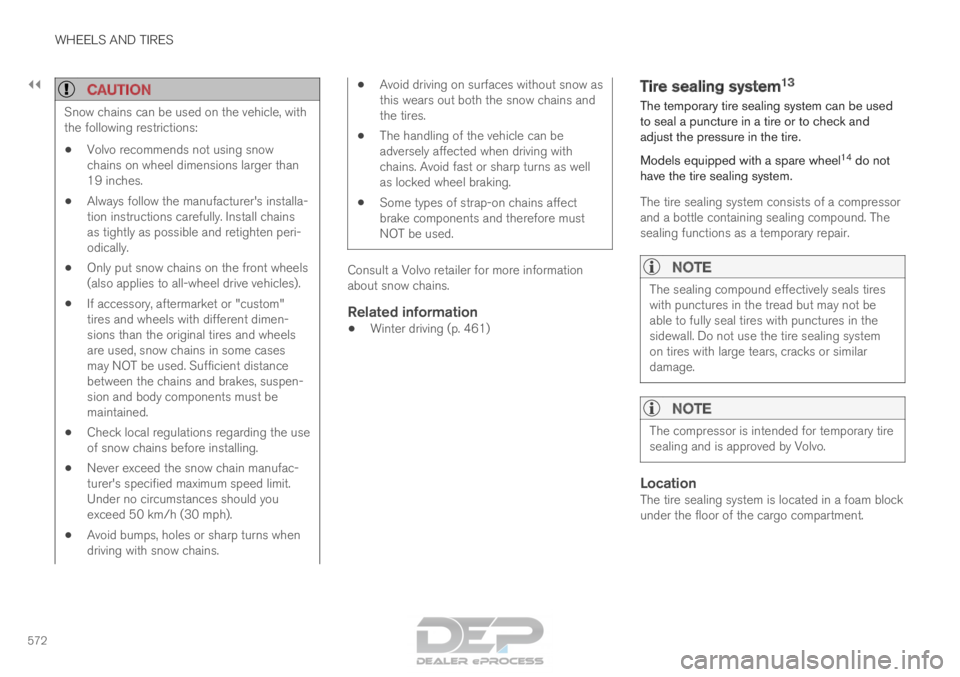ECO mode VOLVO XC90 TWIN ENGINE 2018 Manual Online
[x] Cancel search | Manufacturer: VOLVO, Model Year: 2018, Model line: XC90 TWIN ENGINE, Model: VOLVO XC90 TWIN ENGINE 2018Pages: 686, PDF Size: 17 MB
Page 562 of 686

||WHEELS AND TIRES
* Option/accessory.
560 function, the telltale will flash for approximately
one minute and then remain continuously illumi-
nated. This sequence will continue upon subse-
quent vehicle start-ups as long as the malfunc-
tion exists. When the malfunction indicator is illu-
minated, the system may not be able to detect or
signal low tire pressure as intended.
TPMS malfunctions may occur for a variety of
reasons, including the installation of replacement
or alternate tires or wheels on the vehicle that
prevent the TPMS from functioning properly.
Always check the TPMS malfunction telltale after
replacing one or more tires or wheels on your
vehicle to ensure that the replacement or alter-
nate tires and wheels allow the TPMS to con-
tinue to function properly.
Messages in the instrument panelIf tire pressure is too low, the low tire pressure
warning symbol is shown in the instrument panel
along with a message.
• Tire pressure low Check tires, calibrate
after fill
• Tire pressure system Temporarily
unavailable
• Tire pressure system Service required
To keep in mind
•Always calibrate the system after changing
wheels or adjusting tire pressure. See the tire pressure placard on the driver's side B pillar
for Volvo-recommended tire pressures.
• If you switch to a tire of another size than the
factory-mounted tires, the system must be
calibrated for these tires to avoid false warn-
ings.
• If a spare wheel 7
is used, it is possible that
the tire pressure monitoring system will not
work correctly due to the differences
between the wheels.
• The system does not replace the need for
regular tire inspection and maintenance.
• It is not possible to deactivate the tire pres-
sure monitoring system.
WARNING •
Incorrect inflation pressure could lead to
tire failure, which could cause the driver
to lose control of the vehicle.
• The system cannot predict sudden tire
damage.
Related information
• Recommended tire pressure (p. 559)
• Viewing tire pressure status in the center
display* (p. 562)
• Action when warned of low tire pressure
(p. 563) •
Calibrating the tire pressure monitoring sys-
tem* (p. 561) 7
Not available on all models.
Page 564 of 686

||WHEELS AND TIRES
* Option/accessory.
562
NOTE Always remember to calibrate the Tire Pres-
sure Monitoring System when the wheels
have been changed or the tire inflation pres-
sure has been corrected according to the tire
pressure decal or tire inflation pressure table.
If correct reference values have not been set,
the system cannot issue low tire pressure
alerts correctly.
The vehicle must be stationary with the
engine running to access the calibration but-
ton and to start the calibration process.
WARNING
The exhaust gases contain carbon monoxide,
which is invisible and odorless but very poi-
sonous. For this reason, always perform the
calibration procedure outdoors or in a work-
shop with exhaust gas evacuation equipment.
Related information
•
Recommended tire pressure (p. 559)
• Adjusting tire pressure (p. 558)
• Viewing tire pressure status in the center
display* (p. 562)
• Action when warned of low tire pressure
(p. 563)
• Tire pressure monitoring system* (p. 559) Viewing tire pressure status in the
center display*
With the system for tire pressure monitoring,
Tyre Pressure Monitoring System (TPMS), tire
pressure status can be viewed in the center dis-
play.
Checking status1. Open the Car status app in App view. 2.
Tap TPMS to display the status of the tires.
Status indicator light
The graphic in the center display shows the sta-
tus of each tire 8
. Green tire:
• Inflation pressure is above the warning
threshold.
Yellow tire:
• The tire's inflation pressure is too low. Stop
and check/inflate the tire as soon as possi-
ble. Recalibrate the system after adjusting
the tire pressure.
All tires yellow:
• The inflation pressure is too low in one or
more tires. Stop and check/inflate the tires
as soon as possible. Recalibrate the system
after adjusting tire pressure.
All tires gray:
• Calibration in progress.
• Status unknown. 8
The illustration is generic. Layout may vary depending on vehicle model \
or software version.
Page 566 of 686

||WHEELS AND TIRES
* Option/accessory.
564
Related information
• Recommended tire pressure (p. 559)
• Adjusting tire pressure (p. 558)
• Calibrating the tire pressure monitoring sys-
tem* (p. 561)
• Viewing tire pressure status in the center
display* (p. 562)
• Tire pressure monitoring system* (p. 559)
• Inflate tires with the compressor included in
the tire sealing system (p. 577) When changing wheels
The wheels can be changed, e.g. to switch to
snow tires or spare tires. Follow the applicable
instructions for removing and installing the
wheel.
Changing to tires of another dimensionMake sure that the tire dimension is approved for
use on the vehicle.
If you change to tires of another dimension, con-
tact an authorized Volvo workshop to update the
vehicle's software. A software update may be
necessary when changing to tires of larger/
smaller dimensions or when changing to or from
snow tires.
Related information
• Removing a wheel (p. 566)
• Installing a wheel (p. 568)
• Tool kit (p. 564)
• Snow tires (p. 571)
• Spare wheel (p. 569)
• Wheel bolts (p. 565) Tool kit
Tools for e.g. towing or changing wheels are
provided in the vehicle's cargo compartment.
The foam block under the cargo compartment
floor contains the towing eyelet, the tire sealing
system, the tool for removing plastic wheel bolt
covers and the tool for removing the locking
wheel bolts.
If the vehicle is equipped with a spare wheel*
10
, a
jack, lug wrench, and a package with
disposable gloves and a bag for the damaged
wheel are also provided.
Related information
• When changing wheels (p. 564)
• Jack* (p. 565) 10
Not available on all models.
Page 567 of 686

WHEELS AND TIRES
}}
* Option/accessory. 565
Jack*
The jack can be used to lift the vehicle to e.g.
change a wheel. The illustration is generic – the design may vary.
CAUTION •
When not in use, the jack* should be kept
in its storage compartment under the
cargo compartment floor.
• The jack provided with your vehicle is
intended to be used only in temporary sit-
uations such as changing wheels in the
event of a flat tire. Only the jack that
came with your particular model should
be used to lift the vehicle. If the vehicle
needs to be lifted more frequently or for a
prolonged period, using a garage jack or
hoist is recommended. Always follow this
device's instructions for use. The jack needs to be cranked together to the
correct position in order to fit.
Models with leveling control*
If the vehicle is equipped with the optional pneu-
matic suspension, it must be turned off before
the vehicle is lifted on a jack.
Related information
•
Tool kit (p. 564) Wheel bolts
The wheel bolts hold the wheel in place on the
wheel hub.
CAUTION The wheel bolts should be tightened to
140 Nm (103 ft. lbs.). Over-tightening or
under-tightening could damage the threaded
joints.
Only use rims that have been tested and
approved by Volvo and are included in Volvo's
original product range.
Use a torque wrench to check that the wheel
bolts are tightened correctly.
Do not grease the wheel bolt threads.
WARNING
The wheel bolts may need to be tightened
again several days after a wheel change.
Temperature fluctuations and vibrations can
cause them to loosen slightly.
Locking wheel bolts*A tool for removing the locking wheel bolts is
located in the foam block under the cargo com-
partment floor.
Page 568 of 686

||WHEELS AND TIRES
* Option/accessory.
566
Related information
• Removing a wheel (p. 566)
• Installing a wheel (p. 568) Removing a wheel
Instructions for removing a wheel when chang-
ing wheels. Wheel changes must always be car-
ried out correctly.
CAUTION •
When not in use, the jack* should be kept
in its storage compartment under the
cargo compartment floor.
• The jack provided with your vehicle is
intended to be used only in temporary sit-
uations such as changing wheels in the
event of a flat tire. Only the jack that
came with your particular model should
be used to lift the vehicle. If the vehicle
needs to be lifted more frequently or for a
prolonged period, using a garage jack or
hoist is recommended. Always follow this
device's instructions for use.
WARNING •
Apply the parking brake and put the gear
selector in the Park (P) position.
• Block the wheels standing on the ground,
use rigid wooden blocks or large stones.
• Check that the jack is not damaged, the
threads are properly lubricated and it is
free from dirt.
• Be sure the jack is on a firm, level, non-
slippery surface and that it is upright and
not leaning.
• The jack must correctly engage in the
jack attachment.
• No objects should be placed between the
base of the jack and the ground, or
between the jack and the attachment bar
on the vehicle.
• Never let anyone remain in the vehicle
when it is raised on a jack.
• If a tire must be changed near passing
traffic, make sure all passengers move to
a safe location.
• Use a jack intended for the vehicle when
changing a tire. For any other job, use
stands to support the vehicle.
• Never crawl under or allow any part of
your body to be extended under a vehicle
supported by a jack.
Page 570 of 686

||WHEELS AND TIRES
* Option/accessory.
568 10. Crank it up until it is properly aligned and it is
in contact with the vehicle's jack attachment
point. Make sure the top of the jack (or the
garage lift arms) is correctly positioned in the
attachment point, with the bump on the top
of the jack in the recess in the attachment
point and the base positioned vertically under
the attachment point.
11. Turn the jack so that the crank is as far as possible from the side of the vehicle, which
will position the jack's arms perpendicular to
the vehicle's direction of movement.
12. Raise the vehicle until the wheel to be changed can move freely. Unscrew the wheel
bolts and lift off the wheel.
Related information
• Leveling control settings* (p. 453)
• When changing wheels (p. 564)
• Hoisting the vehicle (p. 605)
• Jack* (p. 565)
• Tool kit (p. 564)
• Installing a wheel (p. 568) Installing a wheel
Instructions for installing a wheel during a wheel
change.
NOTE The jack provided with your vehicle is
intended to be used only in temporary situa-
tions such as changing wheels in the event of
a flat tire. Only the jack that came with your
particular model should be used to lift the
vehicle. If the vehicle needs to be lifted more
frequently or for a prolonged period, using a
garage jack or hoist is recommended. Always
follow this device's instructions for use.
WARNING •
Apply the parking brake and put the gear
selector in the Park (P) position.
• Block the wheels standing on the ground,
use rigid wooden blocks or large stones.
• Check that the jack is not damaged, the
threads are properly lubricated and it is
free from dirt.
• Be sure the jack is on a firm, level, non-
slippery surface and that it is upright and
not leaning.
• The jack must correctly engage in the
jack attachment.
• No objects should be placed between the
base of the jack and the ground, or
between the jack and the attachment bar
on the vehicle.
• Never let anyone remain in the vehicle
when it is raised on a jack.
• If a tire must be changed near passing
traffic, make sure all passengers move to
a safe location.
• Use a jack intended for the vehicle when
changing a tire. For any other job, use
stands to support the vehicle.
• Never crawl under or allow any part of
your body to be extended under a vehicle
supported by a jack.
Page 571 of 686

WHEELS AND TIRES
}}
* Option/accessory. 569
1.
Clean the contact surfaces between the
wheel and the wheel hub.
2. Lift the wheel into place. Tighten the wheel bolts securely.
Do not grease the wheel bolt threads.
3. Lower the vehicle so that the wheel cannot rotate.
4. Tighten the wheel bolts in a crisscross pat- tern (as shown in illustration). It is important
that the wheel bolts are securely tightened.
Tighten to a torque of 140 Nm (103 ft.lbs.).
Use a torque wrench to check torque. 5. Press the plastic covers onto the wheel bolts.
WARNING The wheel bolts may need to be tightened
again several days after a wheel change.
Temperature fluctuations and vibrations can
cause them to loosen slightly.
NOTE
•
After inflating a tire, always replace the
valve cap to help prevent valve damage
caused by gravel, dirt, etc.
• Use plastic valve caps only. Metal caps
could corrode and become difficult to
remove.
Related information
•
Leveling control settings* (p. 453)
• When changing wheels (p. 564)
• Hoisting the vehicle (p. 605)
• Jack* (p. 565)
• Tool kit (p. 564)
• Removing a wheel (p. 566) Spare wheel
11
The spare wheel is a Temporary spare and can
be used to temporarily replace a punctured tire
on one of the vehicle's regular wheels. The spare tire is only intended for temporary use.
Replace it with a normal wheel as soon as possi-
ble.
The driving characteristics of the vehicle change
and ground clearance reduces when the spare
wheel is used. Do not wash the vehicle in an
automatic car wash while using the Temporary
Spare.
The recommended tire pressure must be main-
tained regardless of at which position the tempo-
rary spare wheel is used on the vehicle.
If the spare wheel is damaged, a new one can be
purchased from a Volvo retailer.
WARNING Current legislation prohibits the use of the
"Temporary Spare" tire other than as a tem-
porary replacement for a punctured tire. It
must be replaced as soon as possible by a
standard tire. Road holding and handling may
be affected with the "Temporary Spare" in
use. Do not drive faster than 80 km/h
(50 mph).
11
Not available on all models.
Page 573 of 686

WHEELS AND TIRES
}}
571
Snow tires
Snow tires are designed for winter driving.
Volvo recommends snow tires with specific
dimensions. The tire dimensions vary depending
on engine type. When driving with snow tires, the
correct type of tires must be mounted on all four
wheels.
NOTE Contact a Volvo dealer for advice on the best
choice of rims and tires.
Tips for changing snow tiresWhen switching between regular tires and snow
tires, mark the tires according to which side they
were mounted on, e.g. L for left and R for right.
Studded tiresStudded tires should be broken in by driving
500–1000 km (300–600 miles) slowly and gen-
tly to help the studs settle properly in the tires.
This gives the tire, and especially the studs, a
longer service life.
NOTE
Regulations regarding the use of studded
tires vary from country to country.
Tread depthRoad conditions with ice, slush and low tempera-
tures place considerably higher demands on tires
than summer conditions. Volvo therefore recom-
mends not driving on snow tires that have a tread
depth of less than 4 mm (0.15 inch).
Related information
•
When changing wheels (p. 564)
• Winter driving (p. 461)
• Tread wear indicator (p. 553) Snow chains
Using snow chains and/or snow tires can help
improve traction in winter driving conditions.
WARNING Use Volvo genuine snow chains or equivalent
snow chains that are suitable for the vehicle
model and the tire and wheel sizes. Only one-
sided snow chains are permitted.
If uncertain about snow chains, Volvo recom-
mends contacting an authorized Volvo work-
shop. Use of the wrong snow chains could
cause serious damage to the vehicle and
result in an accident.
12
The backrest in the third row of seats* must be folded down.
Page 574 of 686

||WHEELS AND TIRES
572
CAUTION
Snow chains can be used on the vehicle, with
the following restrictions:
• Volvo recommends not using snow
chains on wheel dimensions larger than
19 inches.
• Always follow the manufacturer's installa-
tion instructions carefully. Install chains
as tightly as possible and retighten peri-
odically.
• Only put snow chains on the front wheels
(also applies to all-wheel drive vehicles).
• If accessory, aftermarket or "custom"
tires and wheels with different dimen-
sions than the original tires and wheels
are used, snow chains in some cases
may NOT be used. Sufficient distance
between the chains and brakes, suspen-
sion and body components must be
maintained.
• Check local regulations regarding the use
of snow chains before installing.
• Never exceed the snow chain manufac-
turer's specified maximum speed limit.
Under no circumstances should you
exceed 50 km/h (30 mph).
• Avoid bumps, holes or sharp turns when
driving with snow chains. •
Avoid driving on surfaces without snow as
this wears out both the snow chains and
the tires.
• The handling of the vehicle can be
adversely affected when driving with
chains. Avoid fast or sharp turns as well
as locked wheel braking.
• Some types of strap-on chains affect
brake components and therefore must
NOT be used. Consult a Volvo retailer for more information
about snow chains.
Related information
•
Winter driving (p. 461) Tire sealing system
13
The temporary tire sealing system can be used
to seal a puncture in a tire or to check and
adjust the pressure in the tire.
Models equipped with a spare wheel 14
do not
have the tire sealing system.
The tire sealing system consists of a compressor
and a bottle containing sealing compound. The
sealing functions as a temporary repair.
NOTE The sealing compound effectively seals tires
with punctures in the tread but may not be
able to fully seal tires with punctures in the
sidewall. Do not use the tire sealing system
on tires with large tears, cracks or similar
damage.
NOTE
The compressor is intended for temporary tire
sealing and is approved by Volvo.
LocationThe tire sealing system is located in a foam block
under the floor of the cargo compartment.
Page 575 of 686

WHEELS AND TIRES
}}
573
Sealing compound bottleThe sealing compound bottle must be replaced if
its expiration date has passed (see the decal on
the bottle). Handle the old bottle as hazardous
waste.
The sealing compound bottle must be replaced
after use. Volvo recommends contacting an
authorized Volvo workshop for replacement.
Related information
• Using the tire sealing system (p. 573)
• Inflate tires with the compressor included in
the tire sealing system (p. 577)
• Tires (p. 550) Using the tire sealing system
Sealing a tire using the tire sealing system, the
Temporary Mobility Kit (TMK).
Overview Electrical cable
Hose
Air release valve
Protective hose cover
Speed limit sticker
Bottle holder (orange cover)
Air pressure gauge Sealing compound bottle
SwitchConnecting
NOTE
Do not break the seal of the bottle before
use. The seal is broken automatically when
the bottle is screwed into place.
13
Certain models only.
14 Not available on all models.